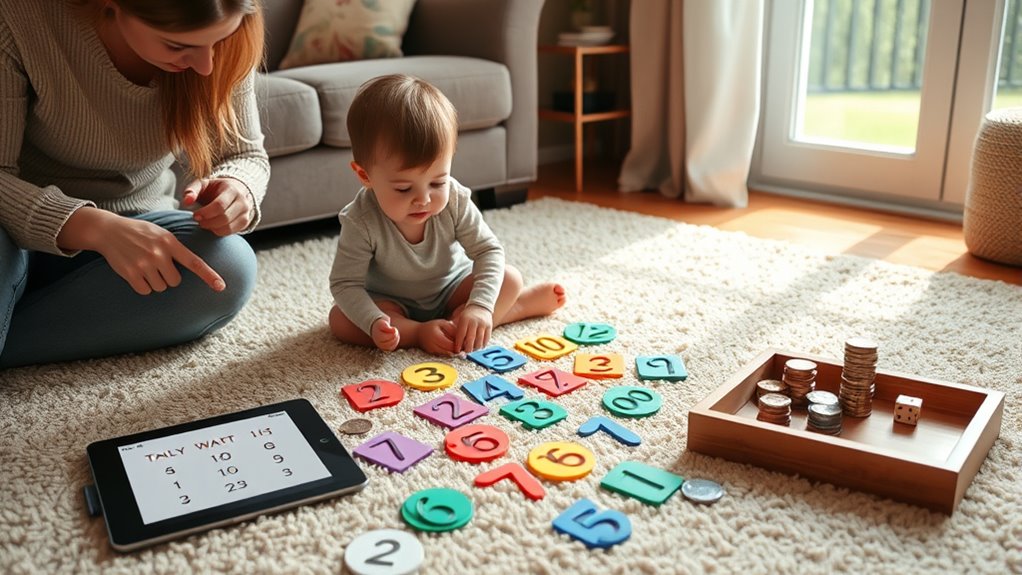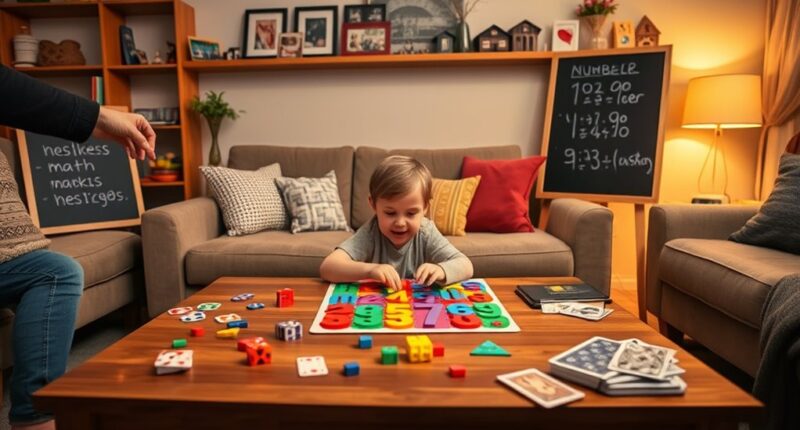You can build your child’s number sense at home through simple, everyday activities that turn routine moments into math fun. Use cooking to practice doubling recipes or estimating time, and challenge them to recognize patterns on clocks, receipts, or phone numbers. Play skip counting or fill in missing numbers with everyday objects. These games boost mental math, pattern recognition, and confidence, making math natural. Keep exploring these practical ideas to discover even more ways to help your child love numbers.
Key Takeaways
- Incorporate mental math into daily routines like cooking, walking, and routine activities to build practical number sense.
- Use pattern recognition in everyday objects, such as clocks and receipts, to develop logical and mathematical thinking.
- Play skip counting, sequence filling, and pattern hunts to reinforce understanding of number patterns naturally.
- Connect math concepts to real-life scenarios for seamless, meaningful learning experiences at home.
- Engage children with simple, fun activities that improve mental calculations and foster confidence in math skills.

Have you ever wondered how you can boost your child’s confidence with numbers right at home? One effective way is by engaging them in simple, fun activities that develop their mental math skills and understanding of number patterns. These skills form the foundation for more advanced math concepts and help children see numbers as something familiar and manageable. You don’t need fancy tools or expensive resources—just everyday opportunities to turn routine moments into learning experiences.
Start by introducing quick mental math games during daily routines. For example, while cooking, ask your child to help double a recipe or split it into smaller portions. This encourages them to perform mental calculations without paper or a calculator, enhancing their ability to think on their feet. You can also challenge them to calculate how many steps it takes to walk around the house or how many minutes remain until dinner. These activities make mental math practical and relevant, helping your child see how math fits into everyday life.
Engage kids in cooking math by doubling recipes and calculating steps to make math fun and practical.
Another great way to strengthen number sense is through exploring number patterns. Look for patterns in the numbers around you—on clocks, in phone numbers, or on grocery receipts. You might notice that the numbers on a clock increase by ones, or that prices often end in .99, creating a pattern that’s easy to recognize. Encourage your child to identify and predict these patterns. For example, if they see a sequence like 2, 4, 6, 8, ask what comes next. This kind of pattern recognition boosts their understanding of how numbers relate to each other and builds their logical thinking. Recognizing the importance of drivetrain components can also help children understand how different parts work together in a system, much like how patterns connect numbers.
Playing simple games like skip counting or finding missing numbers in a sequence can also reinforce pattern awareness. You can create a game where your child fills in the blank in a number pattern, like 5, 10, __, 20. This activity sharpens their ability to recognize and extend patterns, making abstract concepts more concrete. Additionally, you can turn everyday activities into pattern hunts—spotting patterns in tiles, books, or even the arrangement of items on a shelf. These activities make math feel natural and integrated into daily life.
Frequently Asked Questions
How Can I Adapt Math Games for Different Age Groups?
You can adapt math games for different age groups by incorporating differentiated instruction and choosing age-appropriate activities. For younger children, simplify rules and focus on basic concepts like counting or shapes. Older kids can handle more complex problems and strategic gameplay. Adjust the difficulty level, introduce new challenges, or add collaborative elements to keep all ages engaged. This way, everyone benefits from fun, tailored math practice at home.
What Are Some Low-Cost Materials for At-Home Math Activities?
Imagine you’re channeling your inner MacGyver to make math fun! You can use household items like buttons, bottle caps, or coins as DIY manipulatives, making learning engaging and low-cost. These simple materials turn everyday objects into powerful tools for teaching addition, subtraction, and number patterns. Plus, they’re easily accessible, so you can create a variety of activities without spending a dime. Just get creative and have fun!
How Can I Track My Child’s Progress in Number Sense?
You can track your child’s progress in number sense by using simple assessment strategies like observing their problem-solving skills and asking them to explain their reasoning. Keep a progress tracking chart or journal to note improvements over time. Regularly review their work and set goals together. This active approach helps you identify areas needing extra practice and celebrates their growth in understanding numbers.
Are There Online Resources to Supplement These At-Home Games?
Yes, there are many online resources to supplement at-home number sense games. Digital tools and interactive platforms like Math Playground, Khan Academy, and ABCmouse offer engaging activities that reinforce math concepts. You can explore these to keep your child motivated and practicing their skills in a fun, interactive way. Just set aside regular time to navigate these platforms together, helping your child build confidence and understanding in math.
How Much Time Should I Dedicate to Daily Math Practice?
You should aim for about 15 to 20 minutes of daily math practice to boost number sense and skill development. Consistent, focused sessions help reinforce concepts without causing fatigue. Use engaging activities and incorporate variety to keep your child motivated. Prioritize quality over quantity, ensuring they understand the fundamentals. Regular, short practice sessions build confidence and improve their ability to apply math skills in everyday situations.
Conclusion
By incorporating these simple math games into your daily routine, you create a fun, engaging way to build your child’s number sense. Remember, math isn’t just about solving problems; it’s about fostering confidence and curiosity. Think of it as your own personal “magic wand” for nurturing lifelong skills. With patience and consistency, you’ll see your child’s understanding grow, turning everyday moments into powerful learning opportunities—no need for a DeLorean, just some creative thinking!









